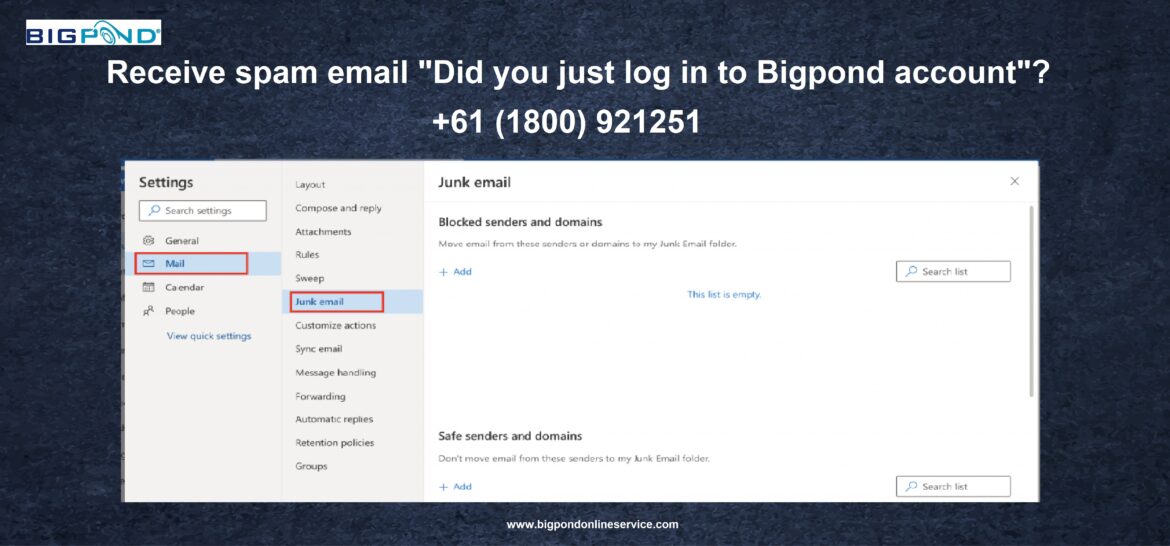
Though these spam emails are commonplace in the current times when the internet is accessed, this is still a big challenge, especially when these emails come with alerts notifying one of logins made to their Bigpond account. Most of these spam email notifications will say that you have logged into your account from a new device or location. Therefore, knowing what these notifications mean, how to identify spam, and what to do is important in ensuring that your individual and online security aren’t compromised.
Claiming Spam Email Alerts
Spam emails can be defined as bulk messages sent by electronic post with no prior individual solicitation. They can range from simple annoyances to more dangerous ones, containing links to malware or phishing sites. Most people receiving emails notifying them of a new login into their Bigpond accounts when they haven’t logged in are part of the reason why phishing has become rampant today. These emails are designed to engage you in providing information in return for nothing. Some of these emails seek to convince you to fill out online forms, including your credentials, especially bank details.
Identifying a Spam Email
Spam email can mostly be identified in simple ways, but phishers today have advanced their game, spicing up their messages to appear real. Here are some signs to look out for:
- Sender’s Address: Check to see whether the email is coming from a bigpond.com or Telstra email address. Phishing emails will often use slightly different email addresses instead of the original address.
- Generic Greetings: Your name may not appear anywhere in the phishing message; instead, “Dear Customer” type greetings are commonly used. A valid Bigpond email is expected to contain the name on the account.
- Urgency and Threats: Phishers often incorporate some form of urgency in their attempts to elicit instant reactions from victims. Avoid any emails claiming that your account requires immediate verification, or else it will be closed.
- Link Destinations: Hover over the hyperlinks in the email, but do not click on them. If the link is unrelated or does not lead to the Telstra or Bigpond website, it should be regarded as phishing.
Reactions Toward Suspicious Emails
In the event that you receive an email that looks suspicious, undertake the following measures to protect your account:
- Do Not Click on the Links: If you doubt the authenticity of the email, do not click on any links or download any attachments.
- Contact Through the Official Site: Use the official Bigpond or Telstra site by typing the address directly into the browser instead of following links. After logging into your account, check for messages related to your account security or recent activity.
- Send a Report About the Email: Report such emails to the Telstra support team. This helps protect your account and also helps prevent such attacks on others.
- Change Password: If you realize that a compromise of your account has taken place, change your password immediately. Ensure it is complex and not related to any other account apart from your Bigpond account.
How to Avoid More Unsolicited Spam
To help you avoid spam and phishing emails in the long run, you may want to apply the following:
- Email Filters: Bigpond users can benefit from email filters, which can block out unwanted emails.
- Revise Security Settings: Regularly revise the security settings of your account by changing the password, updating security questions, and changing the email or phone number linked to the web provider’s site. Set up two-factor authentication (2FA) if it is available.
- Stay Informed: Stay updated on the latest phishing tactics. Telstra occasionally releases updates, such as alerts for recent phishing email scams.
Conclusion
Awareness and caution toward spam and phishing emails are the first steps in protecting oneself from the risks associated with cybercrime. Resist the urge to click on links in emails claiming unusual activity in your Bigpond account. Employing best practices for online security can help prevent falling victim to scams. Ultimately, the responsibility for ensuring that one’s private, sensitive information is not compromised lies with the individual.